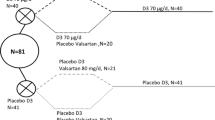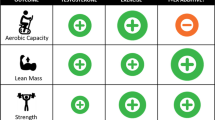Abstract
We hypothesized that treatment with testosterone (T) and recombinant human growth hormone (rhGH) would increase lean mass (LM) and muscle strength proportionally and an in a linear manner over 16 weeks. This was a multicenter, randomized, controlled, double-masked investigation of T and rhGH supplementation in older (71 ± 4 years) community-dwelling men. Participants received transdermal T at either 5 or 10 g/day as well as rhGH at 0, 3.0 or 5.0 μg/kg/day for 16 weeks. Body composition was determined by dual-energy X-ray absorptiometry (DEXA) and muscle performance by composite one-repetition maximum (1-RM) strength and strength per unit of lean mass (muscle quality, MQ) for five major muscle groups (upper and lower body) at baseline, week 8 and 17. The average change in total LM at study week 8 compared with baseline was 1.50 ± 1.54 kg (P < 0.0001) in the T only group and 2.64 ± 1.7 (P < 0.0001) in the T + rhGH group and at week 17 was 1.46 ± 1.48 kg (P < 0.0001) in the T only group and 2.14 ± 1.96 kg (P < 0.0001) in the T + rhGH group. 1-RM strength improved modestly in both groups combined (12.0 ± 23.9%, P < 0.0001) at week 8 but at week 17 these changes were twofold greater (24.7 ± 31.0%, P < 0.0001). MQ did not significantly change from baseline to week 8 but increased for the entire cohort, T only, and T + rhGH groups by week 17 (P < 0.001). Despite sizeable increases in LM measurements at week 8, tests of muscle performance did not show substantive improvements at this time point.


Similar content being viewed by others
References
Bassey EJ, Bendall MJ, Pearson M (1988) Muscle strength in the triceps surae and objectively measured customary walking activity in men and women over 65 years of age. Clin Sci (Lond) 74:85–89
Baumgartner RN, Koehler KM, Gallagher D, Romero L, Heymsfield SB, Ross RR, Garry PJ, Lindeman RD (1998) Epidemiology of sarcopenia among the elderly in New Mexico. Am J Epidemiol 147:755–763
Bhasin S, Woodhouse L, Storer TW (2001) Proof of the effect of testosterone on skeletal muscle. J Endocrinol 170:27–38
Blackman MR, Sorkin JD, Munzer T, Bellantoni MF, Busby-Whitehead J, Stevens TE, Jayme J, O’Connor KG, Christmas C, Tobin JD, Stewart KJ, Cottrell E, St Clair C, Pabst KM, Harman SM (2002) Growth hormone and sex steroid administration in healthy aged women and men: a randomized controlled trial. JAMA 288:2282–2292
Clague JE, Wu FC, Horan MA (1999) Difficulties in measuring the effect of testosterone replacement therapy on muscle function in older men. Int J Androl 22:261–265
Corpas E, Harman SM, Pineyro MA, Roberson R, Blackman MR (1992) Growth hormone (GH)-releasing hormone-(1–29) twice daily reverses the decreased GH and insulin-like growth factor-I levels in old men. J Clin Endocrinol Metab 75:530–535
Dutta C (1997) Significance of sarcopenia in the elderly. J Nutr 127:992S–993S
Emmelot-Vonk MH, Verhaar HJ, Nakhai Pour HR, Aleman A, Lock TM, Bosch JL, Grobbee DE, van der Schouw YT (2008) Effect of testosterone supplementation on functional mobility, cognition, and other parameters in older men: a randomized controlled trial. JAMA 299:39–52
Frontera WR, Hughes VA, Fielding RA, Fiatarone MA, Evans WJ, Roubenoff R (2000) Aging of skeletal muscle: a 12-yr longitudinal study. J Appl Physiol 88:1321–1326
Giannoulis MG, Sonksen PH, Umpleby M, Breen L, Pentecost C, Whyte M, McMillan CV, Bradley C, Martin FC (2006) The effects of growth hormone and/or testosterone in healthy elderly men: a randomized controlled trial. J Clin Endocrinol Metab 91:477–484
Gruenewald DA, Matsumoto AM (2003) Testosterone supplementation therapy for older men: potential benefits and risks. J Am Geriatr Soc 51: 101–115; discussion 115
Harman SM, Metter EJ, Tobin JD, Pearson J, Blackman MR (2001) Longitudinal effects of aging on serum total and free testosterone levels in healthy men. Baltimore Longitudinal Study of Aging. J Clin Endocrinol Metab 86:724–731
Inaba M, Kurajoh M, Okuno S, Imanishi Y, Yamada S, Mori K, Ishimura E, Yamakawa T, Nishizawa Y (2010) Poor muscle quality rather than reduced lean body mass is responsible for the lower serum creatinine level in hemodialysis patients with diabetes mellitus. Clin Nephrol 74:266–272
Iranmanesh A, Lizarralde G, Johnson ML, Veldhuis JD (1991) Nature of altered growth hormone secretion in hyperthyroidism. J Clin Endocrinol Metab 72:108–115
Johannsson G, Gibney J, Wolthers T, Leung KC, Ho KK (2005) Independent and combined effects of testosterone and growth hormone on extracellular water in hypopituitary men. J Clin Endocrinol Metab 90:3989–3994
Kenny AM, Prestwood KM, Gruman CA, Marcello KM, Raisz LG (2001) Effects of transdermal testosterone on bone and muscle in older men with low bioavailable testosterone levels. J Gerontol A Biol Sci Med Sci 56:M266–M272
Kim J, Wang Z, Heymsfield SB, Baumgartner RN, Gallagher D (2002) Total-body skeletal muscle mass: estimation by a new dual-energy X-ray absorptiometry method. Am J Clin Nutr 76:378–383
Kraemer WJ, Dunn-Lewis C, Comstock BA, Thomas GA, Clark JE, Nindl BC (2010) Growth hormone, exercise, and athletic performance: a continued evolution of complexity. Curr Sports Med Rep 9:242–252
Lynch NA, Metter EJ, Lindle RS, Fozard JL, Tobin JD, Roy TA, Fleg JL, Hurley BF (1999) Muscle quality I. Age-associated differences between arm and leg muscle groups. J Appl Physiol 86:188–194
Meinhardt U, Nelson AE, Hansen JL, Birzniece V, Clifford D, Leung KC, Graham K, Ho KK (2010) The effects of growth hormone on body composition and physical performance in recreational athletes: a randomized trial. Ann Intern Med 152:568–577
Newman AB, Kupelian V, Visser M, Simonsick EM, Goodpaster BH, Kritchevsky SB, Tylavsky FA, Rubin SM, Harris TB (2006) Strength, but not muscle mass, is associated with mortality in the health, aging and body composition study cohort. J Gerontol A Biol Sci Med Sci 61:72–77
Orwoll E, Lambert LC, Marshall LM, Blank J, Barrett-Connor E, Cauley J, Ensrud K, Cummings SR (2006) Endogenous testosterone levels, physical performance, and fall risk in older men. Arch Intern Med 166:2124–2131
Page ST, Amory JK, Bowman FD, Anawalt BD, Matsumoto AM, Bremner WJ, Tenover JL (2005) Exogenous testosterone (T) alone or with finasteride increases physical performance, grip strength, and lean body mass in older men with low serum T. J Clin Endocrinol Metab 90:1502–1510
Penninx BW, Guralnik JM, Ferrucci L, Simonsick EM, Deeg DJ, Wallace RB (1998) Depressive symptoms and physical decline in community-dwelling older persons. JAMA 279:1720–1726
Rantanen T, Penninx BW, Masaki K, Lintunen T, Foley D, Guralnik JM (2000) Depressed mood and body mass index as predictors of muscle strength decline in old men. J Am Geriatr Soc 48:613–617
Sattler FR, Castaneda-Sceppa C, Binder EF, Schroeder ET, Wang Y, Bhasin S, Kawakubo M, Stewart Y, Yarasheski KE, Ulloor J, Colletti P, Roubenoff R, Azen SP (2009) Testosterone and growth hormone improve body composition and muscle performance in older men. J Clin Endocrinol Metab 94:1991–2001
Sattler F, Bhasin S, He J, Chou CP, Castaneda-Sceppa C, Yarasheski K, Binder E, Schroeder ET, Kawakubo M, Zhang A, Roubenoff R, Azen S (2011) Testosterone threshold levels and lean tissue mass targets needed to enhance skeletal muscle strength and function: the HORMA trial. J Gerontol A Biol Sci Med Sci 66:122–129
Schroeder ET, Terk M, Sattler FR (2003) Androgen therapy improves muscle mass and strength but not muscle quality: results from two studies. Am J Physiol Endocrinol Metab 285:E16–E24
Schroeder ET, Vallejo AF, Zheng L, Stewart Y, Flores C, Nakao S, Martinez C, Sattler FR (2005) Six-week improvements in muscle mass and strength during androgen therapy in older men. J Gerontol A Biol Sci Med Sci 60:1586–1592
Schroeder ET, Castaneda-Sceppa C, Wang Y, Binder EF, Kawakubo M, Stewart Y, Storer T, Roubenoff R, Bhasin S, Yarasheski KE, Sattler FR, Azen SP (2007a) Hormonal regulators of muscle and metabolism in aging (HORMA): design and conduct of a complex, double masked multicenter trial. Clin Trials 4:560–571
Schroeder ET, Wang Y, Castaneda-Sceppa C, Cloutier G, Vallejo AF, Kawakubo M, Jensky NE, Coomber S, Azen SP, Sattler FR (2007b) Reliability of maximal voluntary muscle strength and power testing in older men. J Gerontol A Biol Sci Med Sci 62:543–549
Snyder PJ, Peachey H, Hannoush P, Berlin JA, Loh L, Lenrow DA, Holmes JH, Dlewati A, Santanna J, Rosen CJ, Strom BL (1999) Effect of testosterone treatment on body composition and muscle strength in men over 65 years of age. J Clin Endocrinol Metab 84:2647–2653
St-Onge MP, Wang Z, Horlick M, Wang J, Heymsfield SB (2004) Dual-energy X-ray absorptiometry lean soft tissue hydration: independent contributions of intra- and extracellular water. Am J Physiol Endocrinol Metab 287:E842–E847
Tracy BL, Ivey FM, Hurlbut D, Martel GF, Lemmer JT, Siegel EL, Metter EJ, Fozard JL, Fleg JL, Hurley BF (1999) Muscle quality. II. Effects of strength training in 65- to 75-yr-old men and women. J Appl Physiol 86:195–201
Wald M, Meacham RB, Ross LS, Niederberger CS (2006) Testosterone replacement therapy for older men. J Androl 27:126–132
Wang Z, Deurenberg P, Wang W, Pietrobelli A, Baumgartner RN, Heymsfield SB (1999) Hydration of fat-free body mass: new physiological modeling approach. Am J Physiol 276:E995–E1003
Acknowledgments
We gratefully acknowledge the volunteer participants who committed substantial time and efforts to make this study successful. Support for this trial was provided in part from the National Institutes of Health R01 AG18169 and local NCRR GCRC M0I RR000043 at USC, the US Department of Agriculture (USDA) ARS Cooperative Agreement 58-1950-9-001, the NCRR GCRC grant M01 RR000054 at Tufts University, where any opinions, findings, conclusions, or recommendations expressed in this publication are those of the authors and do not necessarily reflect the view of the USDA, and the NCRR GCRC at Washington University School of Medicine (M01 RR000036), the Mass Spectrometry Research Resource at Washington University (NIH RR000954, DK020579, and DK056341), and NIH grants U01AG14369 and 1R01DK70534 at Boston Medical Center, Boston University School of Medicine. Study therapies were provided by Solvay Pharmaceuticals Inc, Genentech Inc, and TAP Pharmaceutical Products Inc; industry sponsors provided no monetary support.
Author information
Authors and Affiliations
Corresponding author
Additional information
Communicated by William J. Kraemer.
National Clinical Trials Number: NCT00183040.
Rights and permissions
About this article
Cite this article
Schroeder, E.T., He, J., Yarasheski, K.E. et al. Value of measuring muscle performance to assess changes in lean mass with testosterone and growth hormone supplementation. Eur J Appl Physiol 112, 1123–1131 (2012). https://doi.org/10.1007/s00421-011-2077-y
Received:
Accepted:
Published:
Issue Date:
DOI: https://doi.org/10.1007/s00421-011-2077-y




